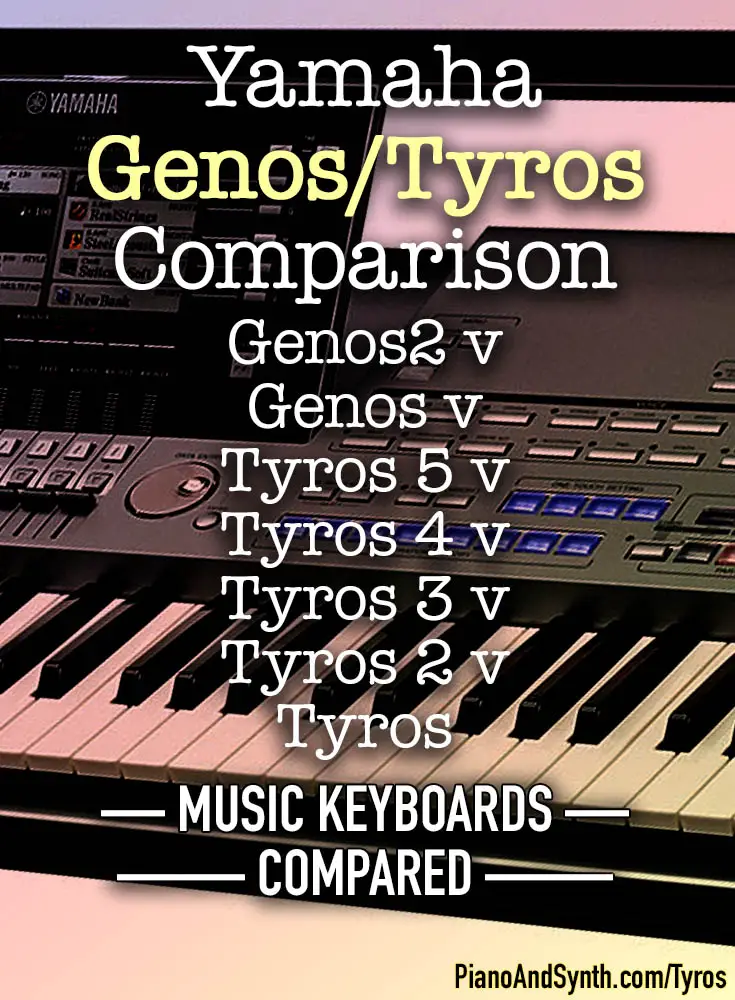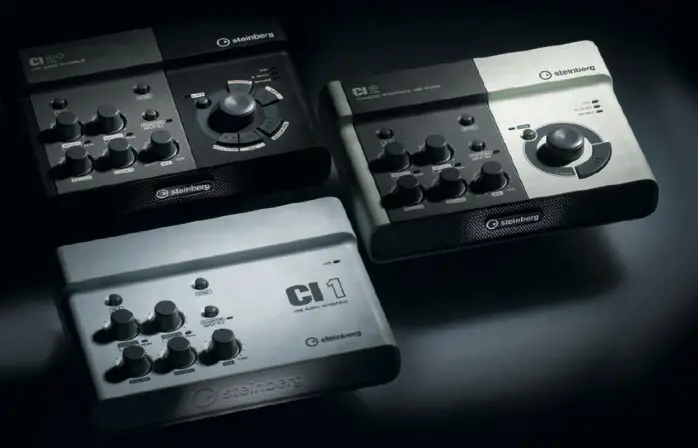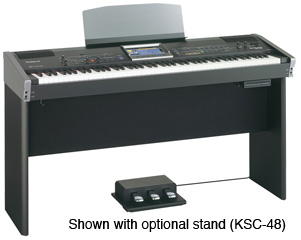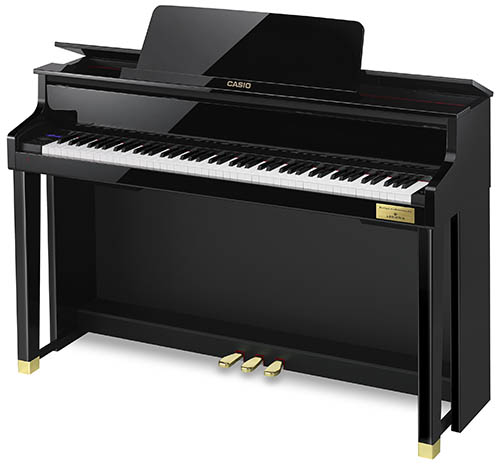Updated November 2023
Yamaha has marked the Tyros 5 as discontinued, meaning it will no longer be manufacturing this model. It now effectively considers the Tyros line of arranger workstations to be at an end, with the likes of the Genos2, Genos and higher-end PSR-S models stepping in to take their place. Of course, it will still be possible to pick up used Tyros models, so read on for a detailed look at the difference between each of the five incarnations of Yamaha’s once-flagship music keyboards.
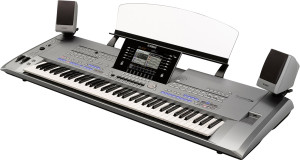
Yamaha has launched five versions of its flagship TYROS arranger workstation keyboards, plus the Genos and Genos2 which are the natural flagship progression from Tyros. Here we look at the differences between the instruments, and see how this product line has evolved over time.
Launch History
- Tyros (May 2002)
- Tyros 2 (June 2005)
- Tyros 3 (April 2008)
- Tyros 4 (June 2010)
- Tyros 5 (July 2013)
- Genos (November 2017)
- Genos2 (November 2023)
Yamaha launched a new Tyros model roughly every three years (two years between the Tyros 3 and Tyros 4). Many had been expecting a Tyros 6 for quite some time. Yamaha’s new Genos top-of-the-line workstation is effectively a Tyros 6 in all but name, and arrived just over 4 years after the Tyros 5 was launched. It was a six year wait until the Genos2 launched. Yamaha continues to expand its other arranger workstation ranges, such as the PSR-S line.
Overview of Differences
Here’s our overview of the key differences between the Genos2, Genos, Tyros5, Tyros4, Tyros3, Tyros2 and Tyros, so you can decide which model is the best option to get.
Yamaha officially only sells the Genos now, with all Tyros models being listed as “Discontinued”. That doesn’t mean you can’t pick up second-hand products for each of these instruments, so long as you’re careful when buying from third parties that you’re getting something that still works and is in good condition.
What’s New on Genos2?

The Genos2 builds on the Genos, and again only comes in a 76 key model.
As well as the AWM stereo sampling and AEM technology, Yamaha has added FM synthesis to the Genos2, meaning it has the potential to create sounds found on Yamaha’s previous FM synthesis instruments such as the iconic DX-7. Polyphony has been increased to 384, with the 128 polyphony FM synthesis accounting for this.
There are some 1,991 voices and 75 drum/SFX kits, a jump in Featured Voices, and increases in on board effects. There are also many more accompaniment styles and features styles.
Key features Yamaha is keen to promote on the Genos2 are an improved set of accompaniment controls, including Real Ambient Drums and AI chord modes. There are said to be a lot of enhancements on the intuitiveness of the instrument, which can’t be seen by simply looking an a specification sheet, so the proof will definitely be in the playing. See our Genos2 article for more information.
What’s New on Genos?

Yamaha does away with a 61-key model completely, preferring to market only a 76-key version. This means an increased price point from the start, although much of the feature set is arguably more usable on a keyboard with a wider note range.
Polyphony has doubled from 128 to 256, with some caveats over usable sounds. That’s the norm for many higher-end keyboards now anyway, so isn’t groundbreaking in itself.
The Genos has a larger touchscreen on board, rather than the smaller non-touch on all Tyros models. This may be welcomed, depending on individual users’ preference for or against touchscreens. There’s also a sub display used for showing various controller information.
Most ‘number of’ specs have been increased, including voices, effects, and some controllers, although there’s nothing brand new on the device compared to the Tyros 5.
Internal storage has been massively increased, up to 58GB from 6.7GB on the Tyros 5. Hard drives are no longer an option, with the Genos opting to save to readily available and cheap USB flash drives instead.
It’s clear from both looks and features that this is an upgraded Tyros in all but name… and why not? The Tyros brand has served many musicians well over the nearly two decades. Genos looks set to continue this.
What’s New on Tyros5?
(Originally written in November 2013)
For the first time, Yamaha offers a 76-key keyboard alongside the familiar form of the 61-key model. Both include a whole range of new or updated on-board features designed to aid musicians in both live performance and music arrangement/recording.
Key features include a plethora of realistic, detailed, nuanced instrument voices, plus a huge range of styles and studio-quality effects.
Ensemble Voices is a new feature which intelligently arranges orchestral instruments – brass, saxophone, woodwind and string – in real time.
There are 40 new +Audio Styles to work with, a new graphical interface, plus Virtual Circuitry Modelling technology which produces accurate reproductions of classic analog synths.
The Yamaha Tyros5 will be available in mid-December 2013 for MSRPs of $6,799 for the 76-note version and $6,499 for 61-note version.
What’s New on Tyros4?
(Originally written in October 2010)
Yamaha boasts an expanded and enhanced set of authentic voices, including new Super Articulation Choir Voices with amazingly realistic and natural human voice sounds.
More advanced Super Articulation and Super Articulation 2 voices, plus advanced MegaVoice variations, mean that auto-accompaniments styles are now much improved.
The Vocal Harmony 2 processing engine offers fast processing for a superior sound plus flexible control of harmonies. There’s also a synth vocoder feature.
Additional premium voices can be downloaded from Yamaha’s Internet site.
Key specifications comparison
| Genos2 | Genos | Tyros5 | Tyros4 | Tyros3 | Tyros2 | Tyros | |
| Keys | 76 | 76 | Tyros5-61: 61 Tyros5-76: 76 | 61 | |||
| Polyphony | 384 | 256 | 128 | ||||
| Aftertouch | Yes | Yes | Yes | ||||
| Touch Response | Yes | Yes | Yes | ||||
| Pitch Bend | Yes | Yes | Yes | ||||
| Modulation Wheel | Yes | Yes | Yes | ||||
| Multi Pads | Yes | Yes | Yes | ||||
| Sliders | 9 Live Control sliders (Assignable, with LED gauge), Cross Fader | 9 Live Control + crossfader | 9 + crossfader | 9 | – | – | – |
| Articulation Switches | 3 | 3 | 2 | 2 | – | – | – |
| Sound System | FM, AWM Stereo Sampling, AEM technology | AWM Stereo Sampling, AEM technology | AWM Stereo Sampling | AWM | |||
| Number of Voices | 1,991 Voices + 75 Drum/SFX Kits | 1652 Voices + 58 Drum/SFX Kits | 1279 Voices + 480 XG Voices + 37 Drum/SFX Kits | 993 Voices + 30 Organ Flutes + 480 XG Voices + 256 GM2 Voices + 44 Drum/SFX Kits (And GS Voices for GS Song playback) | 749 + 20 Organ Flute + 480 XG + 256 GM2 + 35 Drum/SFX Kits (+ GS Voices for GS Song playback) | 486 + 18 Mega + 10 Organ Flute + 480 XG + 256 GM2 + 22 Drum Kits + 6 SFX Kits (+ GS Voices for GS Song playback) | 1185 (403 voices (Normal: 393 + Mega: 10) + 10 Organ Flutes voices + 480 XG voices + 256 GM2 voices + 31 drum kits (XG and Panel: 22 + GM2: 9) + 5 SFX kits) |
| Featured Voices | 106 S.Articulation2, 437 S.Articulation, 141 FM, 40 Sweet!, 81 Cool!, 188 Live!, 25 OrganFlutes, 123 MegaVoice, 11 Ambient Drums/SFX, 11 Revo Drums/SFX | 10 Revo! Drums/SFX, 76 Ensemble, 390 Super Articulation!, 75 Super Articulation2!, 82 MegaVoice, 40 Sweet!, 81 Cool!, 160 Live!, 24 Organ Flutes! | Ensemble 55 S.Art2! 44 / S.Art! 288 MegaVoice 54 / Live! 138 Cool! 81 / Sweet! 37 / Organ World 40 | 15 S.Articulation2! Voices (AEM technology), 164 S.Articulation Voices, 43 MegaVoices, 30 Sweet! Voices, 101 Live! Voices, 44Drums (including SFX Kits), 71 Cool! Voices, 30 Presets Organ Flutes! | 11 S.Articulation2! Voices (AEM technology), 53 S.Articulation Voices, 23 MegaVoices, 26 Sweet! Voices, 70 Live! Voices, Live! Drums (12 drum kits), 58 Cool! Voices, 20 Organ Flutes! | 42 Super Articulation Voices, 18 MegaVoices, 23 Sweet! Voices, 58 Live! Voices, Live! Drums (9 drum kits), 39 Cool! Voices, 10 Organ Flutes! | – |
| Custom | ? | 1.8GB voice sampling | Optional up to 1GB Custom Voice Sampling | 4MB built-in, Optional up to 1GB Custom Voice Sampling | 128 normal / 10 drum max. | ||
| Effects: Reverb | 85 Preset + 30 User | 59 + 3 user | 52 + 3 User | 44 + 3 User | 42 + 3 User | 34 + 3 User | 34 + 3 User |
| Effects: Chorus | 107 + 3 user | 107 + 3 user | 106 + 3 User | 30 + 3 User | 26 + 3 User | ||
| Effects: DSP | 363 Preset (with VCM) + 30 User | Variation: 358 Preset (with VCM) + 3 User | Insertion 1-28: 358 Preset (with VCM) + 10 User | DSP1: 322 presets + 3 user, DSP2-9: 322 presets + 10 user | DSP1–7 : 285 Presets, DSP8–9 : 285 Presets (for Style) | DSP 1-9 (For Voice/Style/Mic): 272 presets + 10 users | DSP Effect For Style: 189 presets + 3 users, DSP Effect For R1/R2/R3/Left: 189 presets + 10 users, DSP Effect For Mic: 189 presets + 10 users | 183 + 3 User, 183 + 10 User |
| Insertion Effect | 1-28: 363 Preset (with VCM) + 30 User | – | – | – | – | – | – |
| Effect: Master Compressor: | 5 + 5 user | 5 + 5 user | 5 Presets + 5 User | ||||
| Effects: Master EQ | 9 Preset + 30 User | 5 + 2 user | 5 Bands : 5 Preset + 2 User | ||||
| Effects: Part EQ | 28 | 28 | ? | 2 Bands: 29 Parts (R1, R2, R3, Left, MultiPad, Style x 8, Song x 16) | |||
| Effects: Others: | Mic effects: Noise Gate, Compressor, 3 Band EQ, Vocal Effect: 23 | Mic Effect: Noise Gate, Compressor, 3 Band EQ | Vocal Effect: 23 | Mic effects: Noise Gate x 1, Compressor x 1, 3Band EQ x 1 | ||||
| Functions: Dual/Layers | ? | ? | Voice layer (RIGHT 1-3) | ||||
| Functions: Split | ? | ? | Up to 3 split points | Separate split points for Chord and Voice (LEFT) | |||
| Functions: Panel Sustain | Yes | Yes | Yes | – | |||
| Functions: Mono/Poly | Yes | Yes | Yes | ||||
| Vocal Harmony | 60 | Vocal Harmony: 54 | Synth Vocoder: 20 | VH2: 44Preset + 10 User | 60 Preset + 10 User | |||
| Number of Accompaniments: | 800 | 550 | 539 | 500 | 450 | 400 | 300 |
| Featured Accompaniment Styles: | 720 Pro, 69 Session, 11 Free Play | 491 Pro, 39 Session, 10 Free Play, 10 DJ | 40 + Audio, 7 FreePlay, 441 Pro, 51 Session | 403 Pro Styles, 47 Session Styles with MegaVoices (used by preset styles) | 403 Pro Styles, 47 Session Styles with MegaVoices (used by preset styles) | – | |
| Accompaniment Fingering: | Single Finger, Fingered, Fingered On Bass, Multi Finger, AI Fingered, Full Keyboard, AI Full Keyboard | ||||||
| Style Control: | INTRO x 3, MAIN VARIATION x 4, FILL x 4, BREAK, ENDING x 3 | ||||||
| Storage | 15GB | 58GB | 6.7MB | 6MB | 3.2MB | 3.3MB | |
| Hard Drive | to USB flash drive | to USB flash drive | 500GB | 250GB | 80GB | Optional | Optional |
| Audio recording time | ? | 80 minutes | ? | ? | ? | ? | |
| Audio recording format | WAV (44.1 kHz, 16 bit, stereo), MP3 (44.1 kHz, 64/96/128/256/320 kbps, stereo) | .wav (WAV format: 44.1 kHz sample rate, 16 bit resolution, stereo) | |||||
| Audio recording playback | WAV (44.1 kHz, 16 bit, stereo), approx. 0.8 GB (80 minutes) per Song | .wav (WAV format: 44.1 kHz sample rate, 16 bit resolution, stereo), .mp3 (MPEG-1 Audio Layer-3: 44.1/48.0 kHz sample rate, 64–320 kbps and variable bit rate, mono/stereo) | |||||
| Time stretch | Yes | Yes | Yes | ||||
| Pitch shift | Yes | Yes | Yes | ||||
| Vocal cancal | Yes | Yes | Yes | ||||
| Multi-recording | ? | ? | .aud (Tyros5 original: 44.1 kHz sample rate, 16 bit resolution, stereo) | ||||
| Multi-playback | ? | ? | .aud (Tyros5 original: 44.1 kHz sample rate, 16 bit resolution, stereo) | ||||
| Display | Main Display : TFT Color Wide VGA LCD | Sub Display: OLED (Live Control view) | TFT VGA 7.5 inch LCD | |||||
| Touchscreen | Yes | Yes | No | No | No | No | No |
What Should You Buy?
If you’re in the market for a Yamaha Tyros/Genos instrument, and price is no object, then you really should consider going for the Yamaha Genos2.
Yamaha no longer sells any of the Tyros models as new. We don’t know how long Yamaha will offer after-sales support for the Yamaha Tyros5. The Genos is currently still on sale.
The Genos2 has an RRP of $5,699, and the Genos of $4,999.
The 61-key Tyros5 had an RRP of US$6499 while the 76-key Tyros5 had an RRP of $,6799, but these were new prices at the time of launch.
If you like the concept of the Genos or Tyros but are in the market for a similar Yamaha arranger workstation, you might also try looking at the higher end PSR range. The PSR-S975 is Yamaha’s current flagship and includes “powerful performance features including versatile effects inherited from the legendary Tyros 5”. It’s also cheaper with an RRP of $2599 although it isn’t available in a 76-key version.
It doesn’t have all the specs of the Genos/Tyros, of course, but it’s quite possible you don’t need all of those functions in any case.
Alternatively, it is definitely worth giving arranger workstations like the Korg Kronos a look. They’ve got a lower RRP and have arguably more features all round. Or take a look at Roland’s E and BK series of arranger workstations. Of course it depends on whether you must have Yamaha, or just want something good regardless of manufacturer.
